By Intern Gloria Kang(2013.11.5)
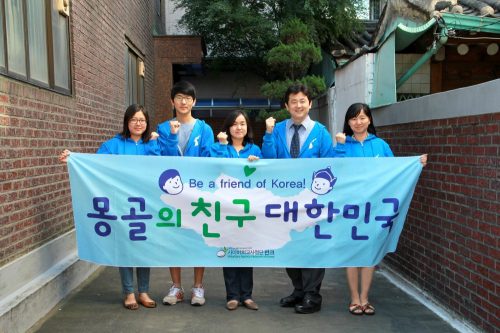 On Monday, September 30th, we gathered at the airport with our suitcases filled with clothes and VANK souvenirs to share with the students we would meet in Mongolia. A brief three hours later, we landed in Mongolia and set off for our hotel. Mongolia was shockingly cold but it was difficult to dampen my excitement.
On Monday, September 30th, we gathered at the airport with our suitcases filled with clothes and VANK souvenirs to share with the students we would meet in Mongolia. A brief three hours later, we landed in Mongolia and set off for our hotel. Mongolia was shockingly cold but it was difficult to dampen my excitement.
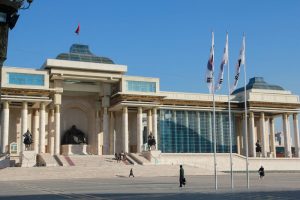 The next day began with an early trip to Sukhbaatar Square, the central square of Ulaanbaatar. There we saw the impressive statues of Genghis Khan, Ogedei Khan, Kublai Khan, and Damdin Sukhbaataar. Our guide described the legacy of these historical figures and the special places they had in the hearts of Mongolian people. We then made our way to the National Museum of Mongolia. The museum provided an excellent introduction to the extensive history and culture of Mongolia. We walked through each exhibition, noting the differences and similarities with our own cultures back home.
The next day began with an early trip to Sukhbaatar Square, the central square of Ulaanbaatar. There we saw the impressive statues of Genghis Khan, Ogedei Khan, Kublai Khan, and Damdin Sukhbaataar. Our guide described the legacy of these historical figures and the special places they had in the hearts of Mongolian people. We then made our way to the National Museum of Mongolia. The museum provided an excellent introduction to the extensive history and culture of Mongolia. We walked through each exhibition, noting the differences and similarities with our own cultures back home.
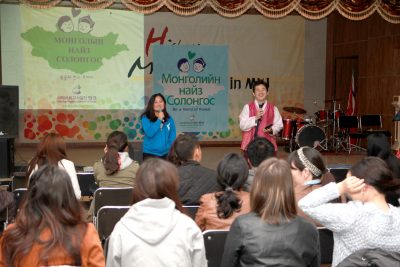
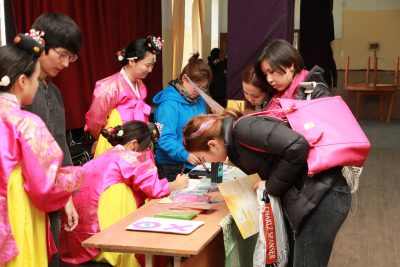
It soon became time for our first event so we made our way over to Mongolia International University. The program was prepared in the following order: introduction by VANK President Gi Tae Park, traditional fan dance, haegeum performance, taekwondo performance, taekkyeon performance, K-pop performance, and finally an interactive True or False quiz.
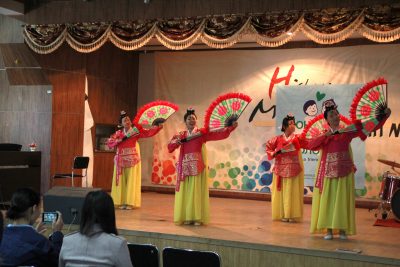
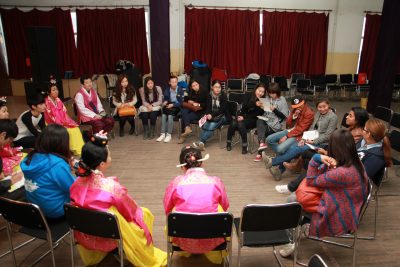
My role comprised of dancing in the traditional fan dance performance, and helping out with ushering and other minor duties. Our initial audience was comprised of a few students who were interested in Korean culture but the group quickly grew during the rest of the event. We were fortunate enough to hold a small forum with a cozy number of students and they expressed their general feelings about our performances, lecture, and main core concepts. I was interested to hear about the historical, political, and social conflicts between Mongolia and China. The university students were kind and articulate about their perspectives and it was eye-opening to exchange dialogue with peers from a different cultural background.
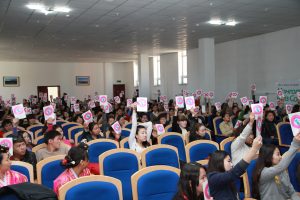 We headed out early on Wednesday morning to Ulaanbataar University only to be greeted by gridlock traffic. After an hour of frustratingly slow progress, we picked up our things and jumped off the bus. Dressed in full hanboks and performance attire, we ran through the streets of Ulaanbataar and drew gazes and stares. We barely arrived on time and set up our things to immediately start our program. The audience for that morning was students who were majoring in Korean Language or Korean Studies. Although our translator was still needed, the audience would laugh and pick up on much of the Korean that was being spoken. The packed room was filled tight with hundreds of responsive students and exuded a heartwarming atmosphere.
We headed out early on Wednesday morning to Ulaanbataar University only to be greeted by gridlock traffic. After an hour of frustratingly slow progress, we picked up our things and jumped off the bus. Dressed in full hanboks and performance attire, we ran through the streets of Ulaanbataar and drew gazes and stares. We barely arrived on time and set up our things to immediately start our program. The audience for that morning was students who were majoring in Korean Language or Korean Studies. Although our translator was still needed, the audience would laugh and pick up on much of the Korean that was being spoken. The packed room was filled tight with hundreds of responsive students and exuded a heartwarming atmosphere.
 After the event, we had a quiet lunch with six Ulaanbataar University students in order to gain some insight on the life of typical Mongolian student. The students discussed academic life, daily life, likes and dislikes, and concerns about post-graduation life. I was able to hear about the Mongolian people’s tension with China, and they shed light on the historical and current social events that played a large role in the Mongolian identity. Some of the students had prior experiences in Korea and they shared their stories with us. They were funny and bright, and I realized once more how easy it can be for people from seemingly completely different backgrounds to truly enjoy each others’ company. Of all the events in Mongolia, this was my personal favorite because of the chance to speak to Mongolian students, hear about their lives, and really engage in cultural exchange. As we parted, I only wished that we could have had a bit more time together.
After the event, we had a quiet lunch with six Ulaanbataar University students in order to gain some insight on the life of typical Mongolian student. The students discussed academic life, daily life, likes and dislikes, and concerns about post-graduation life. I was able to hear about the Mongolian people’s tension with China, and they shed light on the historical and current social events that played a large role in the Mongolian identity. Some of the students had prior experiences in Korea and they shared their stories with us. They were funny and bright, and I realized once more how easy it can be for people from seemingly completely different backgrounds to truly enjoy each others’ company. Of all the events in Mongolia, this was my personal favorite because of the chance to speak to Mongolian students, hear about their lives, and really engage in cultural exchange. As we parted, I only wished that we could have had a bit more time together.
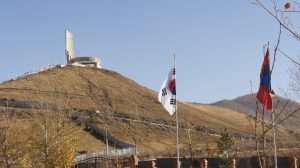
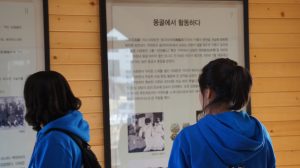 Later in the afternoon, we climbed to the top of Zaisan Memorial, and were rewarded with a breathtaking panoramic view of Ulaanbataar and its adjacent mountain ranges. At the foot of the memorial was a small park commemorating a Korean matyr by the name of Lee Tae Joon. He was involved in the Korean independence movement but he was also a doctor for the Mongolian King and served the Mongolian people. It was fascinating to see and learn about the historical people and events that built bridges between Korea and Mongolia.
Later in the afternoon, we climbed to the top of Zaisan Memorial, and were rewarded with a breathtaking panoramic view of Ulaanbataar and its adjacent mountain ranges. At the foot of the memorial was a small park commemorating a Korean matyr by the name of Lee Tae Joon. He was involved in the Korean independence movement but he was also a doctor for the Mongolian King and served the Mongolian people. It was fascinating to see and learn about the historical people and events that built bridges between Korea and Mongolia.
 The next day, we were at Huree University of Information and Communication Technology. One of the VANK interns spoke about his background in environmental engineering and the collaborations between Mongolia and Korea in order to improve new technologies regarding heating and air pollution. He mentioned how his academic background and his interest in the global community was a harmonious blend with his desire to benefit his country. We spent our evening at the Mongolian National Song & Dance Ensemble. The folk and traditional music, song, dance, and contortion of Mongolia was truly like nothing I’ve ever seen before but it was all riveting and skillfully beautiful.
The next day, we were at Huree University of Information and Communication Technology. One of the VANK interns spoke about his background in environmental engineering and the collaborations between Mongolia and Korea in order to improve new technologies regarding heating and air pollution. He mentioned how his academic background and his interest in the global community was a harmonious blend with his desire to benefit his country. We spent our evening at the Mongolian National Song & Dance Ensemble. The folk and traditional music, song, dance, and contortion of Mongolia was truly like nothing I’ve ever seen before but it was all riveting and skillfully beautiful.
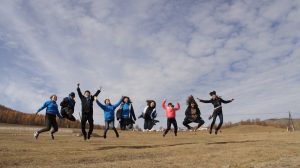 My final day took me to the steppes of Mongolia and we were surrounded by endless mountain ranges. The visual scenery seemed too incredible and grand to be real. Honestly, it was one of the most impressive sights I have ever seen. In the midst of the grand open space and magnificent elevations, I felt so small and dull but simultaneously blessed to be able to be minor part of the same world. Mongolia is truly a dazzling place and my excursion with VANK gave me a chance to actively participate in cultural exchange through unforgettable people, places, and experiences.
My final day took me to the steppes of Mongolia and we were surrounded by endless mountain ranges. The visual scenery seemed too incredible and grand to be real. Honestly, it was one of the most impressive sights I have ever seen. In the midst of the grand open space and magnificent elevations, I felt so small and dull but simultaneously blessed to be able to be minor part of the same world. Mongolia is truly a dazzling place and my excursion with VANK gave me a chance to actively participate in cultural exchange through unforgettable people, places, and experiences.
